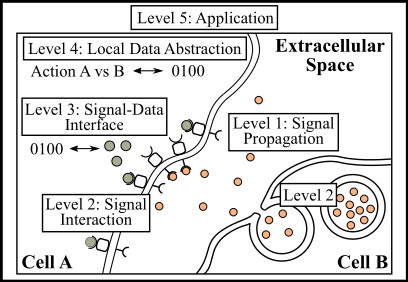BioPhysComm SIMBA Project
Project Overview
The SIMBA project (Signal Propagation and Information in Microscale Biological Applications) seeks to address the gap between the contributions of molecular communications research and applications in relevant disciplines. It is establishing a communications engineering hierarchy for the characterisation and control of cellular behaviour and decision-making.
This project is funded by the UK's EPSRC. In-kind support provided by AstraZeneca Sweden.
Hierarchy for Mapping Communication to Microscale Behaviour
The proposed hierarchy is comprised of 5 levels (as introduced in A Survey of Molecular Communication in Cell Biology: Establishing a New Hierarchy for Interdisciplinary Applications, 2021). The levels are:
- Physical Signal Propagation - models how molecules physically propagate, whether they are transmitted by some “device” or come from the ambient environment.
- Physical/Chemical Signal Interaction - the interface between molecules and the “devices” that send or receive them, including how those molecules are involved in local signalling pathways, e.g., chemical binding kinetics.
- Signal-Data Interface - the interface between the physical signal at “devices” and its representation as quantified data.
- Local Data Abstraction - the quantification of information and what it means at a local “device”, e.g., what activity or state has been observed or what action is to be taken.
- Application - the aggregate behaviour of communicating devices, e.g., quorum sensing by bacteria and other cells.
Hierarchy Example

The proposed communication level hierarchy is applied above to an example cellular signalling environment (Image from A Survey of Molecular Communication in Cell Biology: Establishing a New Hierarchy for Interdisciplinary Applications, 2021). The communicating devices are two cells separated by extracellular space. In this scenario, Level 1 describes the signal propagation across the extracellular space. Levels 2-4 describe the biochemical pathways, signal-data interface, and data abstraction within the individual cells, respectively. Level 5 describes the overall behaviour requiring communication between the two cells.
SIMBA Project Case Studies
The SIMBA project is applying the proposed hierarchy to two case studies:
- Bacterial Behaviour. We will apply the proposed hierarchy to a heterogeneous population of S. coelicolor bacteria mutants produced in the lab of Dr Christophe Corre in the School of Life Sciences.
- Organ-on-a-Chip Systems. We will demonstrate the proposed hierarchy’s potential for pharmaceutical systems by investigating the impact of noisy signal propagation on metabolic regulation in an organ-on-a-chip system developed by AstraZeneca Sweden.
